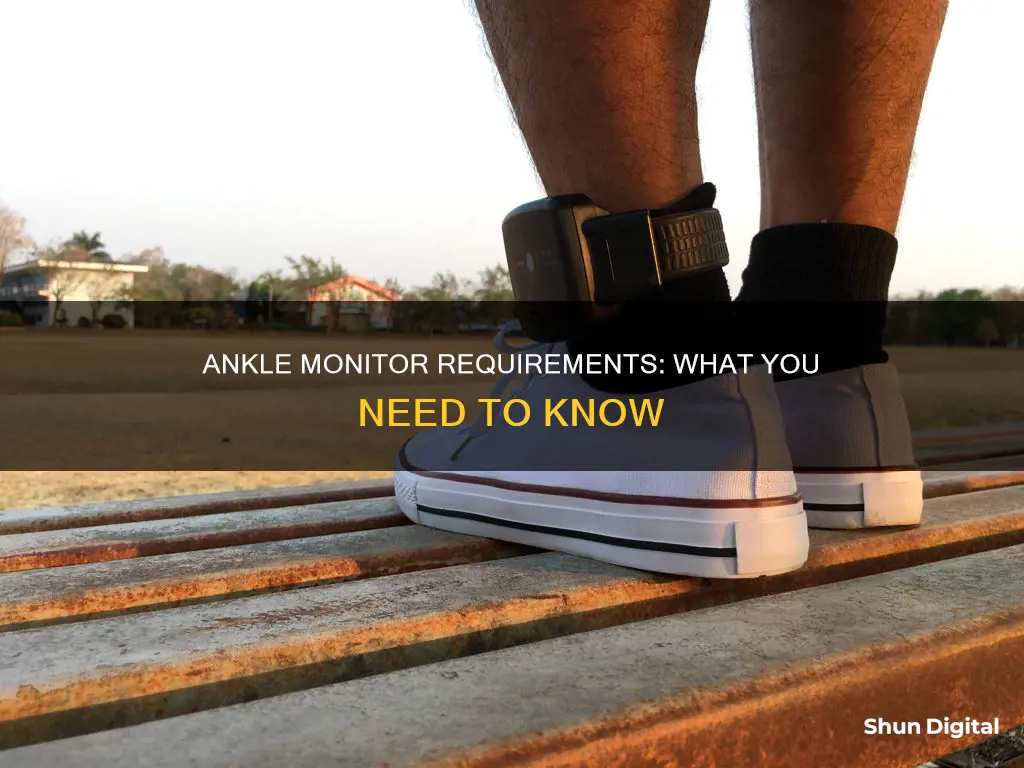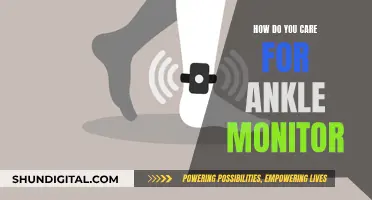
Ankle monitors are often used as an alternative to incarceration, allowing individuals to be punished without taking up space in overcrowded jails. They are typically used for individuals awaiting trial, serving probation or parole, or facing immigration proceedings. The requirements for ankle monitors can vary depending on the situation and the court's decision, but some common conditions include adhering to a specific area, maintaining a job, checking in with a probation officer, and abstaining from drugs and alcohol. Ankle monitors use GPS or radio frequency technology to track an individual's location and ensure compliance with court-ordered restrictions. While they offer a level of freedom compared to incarceration, ankle monitors can also be restrictive and come with social stigma and financial costs.
| Characteristics | Values |
|---|---|
| Purpose | To ensure the wearer doesn't get into more trouble, acts as an alternative to jail time, and reduces bail |
| Wearer | People awaiting trial, those considered a danger to the community or a flight risk, repeat offenders, people with substance abuse issues, people convicted of serious crimes, people convicted of alcohol-related offences, immigrants awaiting court dates |
| Movement | Restricted to a certain radius of the home, with permission to travel to work, religious services, court hearings, medical services, and rehabilitation services |
| Alcohol consumption | Alcohol consumption is restricted, with Secure Continuous Remote Alcohol Monitoring (SCRAM) bracelets detecting alcohol in the wearer's sweat |
| Cost | The wearer may be forced to pay for the ankle monitor, with fees ranging from $3-$35 a day, and initial setup charges of $100-$200 |
| Additional rules | Wearer must keep a job, stay in compliance with all conditions of supervision, pay court fees, meet with probation or parole officers, abstain from drugs |
What You'll Learn

Who is required to wear an ankle monitor?
Ankle monitors are used as an alternative to incarceration, typically for individuals awaiting trial, serving probation or parole, or facing immigration proceedings. They are also used for those on house arrest or bail, or as a condition of mandatory release.
In the US, the use of ankle monitors has been on the rise, with the number of active monitors in use increasing by 140% from 2005 to 2015. This rise can be attributed to the need to reduce prison overcrowding and the COVID-19 pandemic, which saw prisons and jails become hotspots for outbreaks.
Ankle monitors are typically used for individuals charged with minor crimes, such as first-time and non-violent offenders, or as an alternative sentence for those with substance abuse issues. However, they are also used for more serious crimes, such as murder, sexual assault, or major drug offences.
Repeat offenders, particularly those who have violated bail or parole terms in the past, may also be required to wear an ankle monitor. This provides an extra layer of supervision to prevent further offences.
In cases of domestic violence, an ankle monitor can be used to ensure the offender maintains a required distance from the victim.
Ankle monitors are also used for individuals with alcohol-related offences, such as driving under the influence (DUI). These monitors can detect alcohol in a person's sweat, ensuring compliance with court orders not to drink.
The requirements for wearing an ankle monitor vary depending on the individual's situation and the court's decision. Some standard requirements may include:
- Maintaining employment
- Complying with all conditions of supervision
- Paying court fees
- Regularly meeting with a probation or parole officer
- Abstaining from drugs and alcohol
Measuring LCD Monitors: Size, Resolution, and More
You may want to see also

How does an ankle monitor work?
Ankle monitors are typically used as an alternative to pre-trial detention, as a condition of probation, or to reduce bail requirements. They are often used for people who are awaiting trial and are considered a danger to the community or a flight risk. They can also be used as a condition of bail or parole for serious crimes like murder, sexual assault, or major drug offenses.
Ankle monitors are typically strapped to the ankle with a tamper-proof band and are about the size of a pager. They are usually waterproof and shock-resistant, and the wearer is required to keep them charged. The most common type of monitoring is radio frequency (RF), which uses GPS to track the wearer's location. The device transmits a signal to a base unit, usually located in the wearer's home and connected to a landline phone. If the wearer goes outside the designated area, the device vibrates and emits a loud tone. If the wearer does not return to the designated area, the device sends an alert to the authorities.
In addition to tracking location, ankle monitors can also be used to ensure the wearer maintains a required distance from certain people, such as victims of domestic violence. They can also be used to detect alcohol consumption, thus alerting authorities if the wearer violates the terms of their release by drinking.
While ankle monitors can provide a less restrictive alternative to incarceration, they have also been criticised for their negative impact on the wearer's life. For example, they can limit the wearer's ability to work or attend school, and the constant monitoring can lead to stress, anxiety, and social isolation.
Blind Spot Monitoring: A Standard Feature in Teslas?
You may want to see also

What are the rules and restrictions?
Ankle monitors are used as an alternative to incarceration, allowing individuals to remain free while awaiting trial or as a condition of their parole. They are also used to ensure that individuals comply with court-ordered movement and alcohol restrictions. Here are the rules and restrictions that typically apply to individuals wearing ankle monitors:
- Restricted movement: Ankle monitors track the wearer's location and alert authorities if they move outside a designated area. The permitted area is determined by a judge and is based on the wearer's needs and the reason for monitoring. In most cases, individuals on house arrest are not allowed to leave their home address. However, in some cases, they may be permitted to travel to specific locations, such as work, religious services, court hearings, medical appointments, or rehabilitation services. These trips are usually restricted to specific times and must be scheduled in advance.
- Scheduled check-ins: Wearers are typically required to meet with their probation or parole officer at scheduled times. They may also need to check in with a monitoring centre or a halfway house when arriving at or leaving certain locations.
- Abstinence from drugs and alcohol: Ankle monitors can detect alcohol consumption by analysing the wearer's sweat. This feature is used to enforce restrictions on individuals with alcohol-related offences.
- Employment conditions: In some cases, individuals may be required to maintain employment as a condition of their monitoring.
- Court fees: Wearers are often responsible for paying court fees and the daily costs associated with the ankle monitor.
- Tampering restrictions: Ankle monitors are designed to be tamper-resistant and will alert authorities if the wearer attempts to remove or interfere with the device.
It is important to note that the specific rules and restrictions may vary depending on the individual's situation and the jurisdiction.
Hiding Disk Monitoring in Task Manager: A Step-by-Step Guide
You may want to see also

What are the benefits of ankle monitors?
Ankle monitors are often used as an alternative to incarceration, allowing individuals to remain in their community rather than serving time in jail. They are usually worn by people awaiting trial or as a condition of probation. Here are some of the benefits of ankle monitors:
Reduced Risk of Reoffending:
Ankle monitors can help deter individuals from committing further offences. The constant surveillance and knowledge that their movements are being tracked may discourage them from engaging in criminal activities. This can be especially beneficial for repeat offenders or those with a history of reoffending, as it provides an extra layer of supervision to prevent them from committing new crimes.
Alternative to Incarceration:
Ankle monitors offer a less restrictive option compared to imprisonment. They allow individuals to remain in their homes or travel to work, depending on the conditions set by the court. This alternative to jail can be beneficial for low-risk offenders or those with substance abuse issues, as it provides an opportunity for rehabilitation without the negative impacts of incarceration.
Enhanced Supervision and Accountability:
Ankle monitors provide real-time location tracking, enabling authorities to monitor an individual's movements and ensure they adhere to the conditions of their release or probation. This enhanced supervision can help hold offenders accountable and ensure they comply with any restrictions, such as maintaining a certain distance from victims or avoiding specific locations.
Victim Safety and Peace of Mind:
In cases of domestic violence or situations where there is a risk of harm, ankle monitors can provide victims with a greater sense of safety and peace of mind. The tracking devices alert authorities if an offender enters an exclusion zone or gets too close to their victim, allowing for timely intervention and potentially saving lives.
Cost Savings:
Ankle monitors can be a more cost-effective option compared to incarceration. While there may be daily fees associated with the use of ankle monitors, they can still result in overall cost savings for the criminal justice system by reducing the need for incarceration.
Identifying Your Monitor: A Guide to Knowing Your Display
You may want to see also

What are the drawbacks of ankle monitors?
Ankle monitors are often touted as a positive alternative to mass incarceration, allowing people to pay their debt to society while providing for their families. However, there are several drawbacks to this form of monitoring that can have negative impacts on the lives of those forced to wear them.
Firstly, ankle monitors are often described as a form of "digital shackles" that deprive individuals of their liberties. The wearers of these devices are subject to constant surveillance, with their every movement tracked and recorded. This can lead to a loss of privacy and autonomy, as they must adhere to strict rules and regulations set by the court. Any violation of these conditions, such as entering a restricted area or tampering with the device, can result in additional penalties or even a return to jail.
Secondly, the financial burden of ankle monitors can be significant. In some cases, individuals are required to pay daily or monthly fees for the device, which can range from $10 to $35 per day. These costs can quickly accumulate, causing financial strain and, in some instances, even leading to homelessness as individuals struggle to cover the expenses.
Thirdly, ankle monitors can be physically uncomfortable and restrictive. They are typically bulky and must be worn constantly, which can cause skin irritation and chafing. The weight of the device can also be a burden, and wearers must ensure they remain within range of a power source to avoid battery drainage. This constant need for charging can be inconvenient and limit one's mobility and daily activities.
Additionally, ankle monitors have been criticised for their faulty technology. The GPS signal can be unreliable, with frequent losses in connection. This can trigger false alerts and cause unnecessary stress and disruption for the wearer. The devices may also interfere with other technologies, such as phones, leading to further complications.
Lastly, ankle monitors can have a negative impact on one's social life and employment. Wearers may be restricted from certain locations or activities, limiting their ability to socialise or engage in recreational pursuits. The presence of an ankle monitor may also lead to stigma or embarrassment, affecting one's self-esteem and relationships with others.
While ankle monitors offer an alternative to incarceration, it is important to consider the drawbacks and potential negative consequences they can have on individuals' lives. The financial, social, and psychological impacts of these monitoring devices can be significant, and in some cases, may outweigh the benefits of avoiding prison time.
Disabling Motion Blur on ASUS Monitors: A Simple Guide
You may want to see also
Frequently asked questions
An ankle monitor, also known as an ankle bracelet, ankle shackle, or tether, is a device worn around the lower leg to track the movements of individuals who have been sentenced to restricted travel or activities.
Ankle monitors are typically worn by individuals who are either awaiting trial or serving probation and parole. They may also be used for those facing immigration proceedings or individuals charged with minor crimes as an alternative to incarceration.
The requirements for wearing an ankle monitor vary on a case-by-case basis but may include:
- Maintaining employment
- Complying with all conditions of supervision
- Paying court fees
- Regularly meeting with a probation or parole officer
- Abstaining from drugs and alcohol
- Notifying authorities of any changes in schedule or location
Violating the requirements of an ankle monitor can result in additional penalties, including jail time. It is important to understand and adhere to the specific conditions set by the court to avoid further legal consequences.







